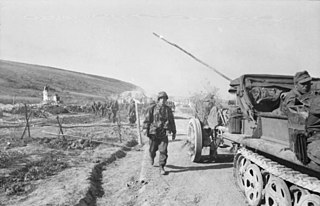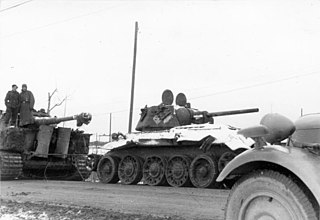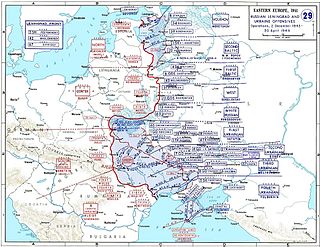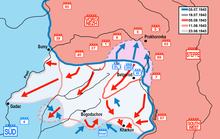
The Battle of Kursk was a Second World War engagement between German and Soviet forces on the Eastern Front near Kursk in the Soviet Union, during July and August 1943. The battle began with the launch of the German offensive Operation Citadel, on 5 July, which had the objective of pinching off the Kursk salient with attacks on the base of the salient from north and south simultaneously. After the German offensive stalled on the northern side of the salient, on 12 July the Soviets commenced their Kursk Strategic Offensive Operation with the launch of Operation Kutuzov against the rear of the German forces on the same side. On the southern side, the Soviets also launched powerful counterattacks the same day, one of which led to a large armoured clash, the Battle of Prokhorovka. On 3 August, the Soviets began the second phase of the Kursk Strategic Offensive Operation with the launch of Operation Polkovodets Rumyantsev against the German forces on the southern side of the salient.

The Third Battle of Kharkov was a series of battles on the Eastern Front of World War II, undertaken by the German Army Group South against the Red Army, around the city of Kharkov between 19 February and 15 March 1943. Known to the German side as the Donets Campaign, and in the Soviet Union as the Donbas and Kharkov operations, the German counterstrike led to the recapture of the cities of Kharkov and Belgorod.

Operation Citadel was a German offensive operation against Soviet forces in the Kursk salient during the Second World War on the Eastern Front that initiated the Battle of Kursk. The deliberate defensive operation that the Soviets implemented to repel the German offensive is referred to as the Kursk Strategic Defensive Operation. The German offensive was countered by two Soviet counter-offensives, Operation Polkovodets Rumyantsev and Operation Kutuzov. For the Germans, the battle was the final strategic offensive that they were able to launch on the Eastern Front. As the Allied invasion of Sicily began, Adolf Hitler was forced to divert troops training in France to meet the Allied threats in the Mediterranean, rather than use them as a strategic reserve for the Eastern Front. Germany's extensive loss of men and tanks ensured that the victorious Soviet Red Army enjoyed the strategic initiative for the remainder of the war.

The Battle of the Korsun–Cherkasy Pocket was a World War II battle fought from 24 January to 16 February 1944 in the course of the Soviet Dnieper–Carpathian Offensive in Ukraine following the Korsun-Shevchenkovsky Offensive. In the battle, the 1st and 2nd Ukrainian Fronts, commanded, respectively, by Nikolai Vatutin and Ivan Konev, encircled German forces of Army Group South in a pocket near the Dnieper River. During weeks of fighting, the two Red Army Fronts tried to eradicate the pocket. The encircled German units attempted a breakout in coordination with a relief attempt by other German forces, resulting in heavy casualties, estimates of which vary.

Operation Winter Storm, a German offensive in December 1942 during World War II, involved the German 4th Panzer Army failing to break the Soviet encirclement of the German 6th Army during the Battle of Stalingrad.

Operation Saturn, revised as Operation Little Saturn, was a Red Army operation on the Eastern Front of World War II that led to battles in the North Caucasus and Donets Basin regions of the Soviet Union from December 1942 to February 1943.
The 1st Panzer Army was a German tank army that was a large armoured formation of the Wehrmacht during World War II.

The 5th SS Panzer Division "Wiking" was a Panzer division among the thirty-eight Waffen-SS divisions of Nazi Germany. It was recruited from foreign volunteers in Denmark, Norway, Sweden, Finland, Estonia, the Netherlands and Belgium under the command of German officers. During the course of World War II, the division served on the Eastern Front. It surrendered in May 1945 to the American forces in Austria.
The IV SS Panzer Corps was a panzer corps of the Waffen-SS of Nazi Germany which saw action on the Eastern Front and in the Balkans during World War II.

The Battle of Prokhorovka was fought on 12 July 1943 near Prokhorovka, 87 kilometres (54 mi) southeast of Kursk in the Soviet Union, during the Second World War. Taking place on the Eastern Front, the engagement was part of the wider Battle of Kursk, and occurred when the 5th Guards Tank Army of the Soviet Red Army attacked the II SS-Panzer Corps of the German Wehrmacht in one of the largest tank battles in military history.

The Second Battle of Kiev was a part of a much wider Soviet offensive in Ukraine known as the Battle of the Dnieper involving three strategic operations by the Soviet Red Army and one operational counterattack by the Wehrmacht, which took place between 3 November and 22 December 1943.
The Voronezh Front was a front of the Soviet Union's Red Army during the Second World War. The name indicated the primary geographical region in which the front first fought, based on the town of Voronezh on the Don River.

The Belgorod-Bogodukhov Offensive Operation was a combat operation executed as part of Operation Polkovodets Rumyantsev by the Red Army against the Wehrmacht forces. It was one of the operations that was launched in response to the German offensive Operation Citadel.

The Dnieper–Carpathian Offensive, also known in Soviet historical sources as the liberation of right-bank Ukraine, was a strategic offensive executed by the Soviet 1st, 2nd, 3rd, and 4th Ukrainian Fronts, along with the 2nd Belorussian Front, against the German Army Group South and Army Group A, and fought from 24 December 1943 – 17 April 1944. The battles on the right-bank Ukraine and in the Crimea were the most important event of the 1944 winter-spring campaign on the Eastern Front.
The Mirgorod direction offensive was an operation conducted as part of Operation Polkovodets Rumyantsev between the Red Army and Wehrmacht forces. It was one of the operations that followed the Battle of Kursk. In the offensive, the Red Army pushed through the Wehrmacht lines after the Wehrmacht retreated after the Battle of Kursk. It represented a turning point on the Eastern Front.

Operation Roland was a local German offensive inside the Soviet Union during the Second World War on the Eastern Front, and was conducted as a local operation within the overarching German summer offensive, Operation Citadel, on the southern side of the Kursk salient. The German forces of the III Panzer Corps and the 2nd SS Panzergrenadier Division Das Reich of the II SS Panzer Corps attempted to envelop and destroy Soviet forces of the Voronezh Front. This operation was necessitated by the failure of the German II SS Panzer Corps to break through Soviet forces during the Battle of Prokhorovka on 12 July. Therefore, German commanders decided to first link up the III Panzer Corps, which had been lagging behind due to heavy Soviet resistance, with the II SS Panzer Corps, in order to consolidate the German positions into a continuous frontline without inward bulges and enable the two panzer corps to overrun Soviet forces defending Prokhorovka together. The linking up of the two German pincers was planned to effectuate the envelopment of the Soviet 69th Army and other supporting units.

The Izyum-Barvenkovo Offensive was a Soviet offensive operation of the Southwestern Front against part of German Army Group South during the World War II. The aim of the operation was to tie down German reserves during the Battle of Kursk and overrun the German forces located in Donbass. Soviet troops managed to cross the Seversky Donets river and seize the bridgehead, but the German counterattacks stopped the further advance.

The Voronezh–Kharkov strategic offensive operation was a successful strategic offensive operation of the Red Army's Voronezh, Bryansk and South-Western fronts, carried out from January 13 to March 3, 1943 with the aim of defeating the German Army Group B and liberating a large territory and the important industrial and administrative centers Voronezh, Kursk, Belgorod and Kharkov.
The 41st Guards Rifle Division was formed as an elite infantry division of the Red Army in August, 1942, based on the 1st formation of the 10th Airborne Corps, and served in that role until after the end of the Great Patriotic War. It was the last of a series of ten Guards rifle divisions formed from airborne corps during the spring and summer of 1942. It was briefly assigned to the 1st Guards Army in Stalingrad Front, then to the 24th Army in Don Front, and suffered heavy casualties north of Stalingrad before being withdrawn to the Reserve of the Supreme High Command for a substantial rebuilding. Returning to 1st Guards Army in Southwestern Front in November it took part in Operation Little Saturn as part of 4th Guards Rifle Corps and then advanced into the Donbass where it was caught up in the German counteroffensive in the spring of 1943. During the summer and fall the division fought its way through eastern Ukraine as part of the 6th, and later the 57th Army under several corps commands. It would remain in the southern part of the front for the duration of the war. By February, 1944 it was in the 7th Guards Army and took part in the battle for the Korsun Pocket, winning its first battle honor in the process. Shortly after it was transferred to the 4th Guards Army, where it would remain for the duration, still moving through several corps headquarters. The 41st Guards saw limited service in the first Jassy-Kishinev offensive in the spring, but considerably more in August's second offensive and several of its subunits received battle honors or decorations. The division itself won a second honorific during the offensive into Hungary in January, 1945 and was later decorated for its role in the capture of Budapest. After the fall of Vienna in April it did garrison duty in the city for a short time before being directed west into lower Austria where it linked up with U.S. forces in the last days of the war. In October, while still in Austria, it was converted to the 18th Guards Mechanized Division.
The 71st Guards Rifle Division was reformed as an elite infantry division of the Red Army in March 1943, based on the 1st formation of the 23rd Rifle Division, and served in that role until after the end of the Great Patriotic War.


















